How to spend 48 hours in Rome
Let’s say that you only have two days to visit Rome, but you really don’t want to lose anything the city has to offer. Fear not! Rome is a very easy city to roam around, given that its main monuments and tourist attractions are close to each other. If you’re ready for a tour de force in the eternal city, this is the right guide for you.
What you will need:
- Comfortable shoes
- A reusable water bottle to drink from the typical Roman Fountains (nasoni)
- A light backpack and a city map or a good GPS (but maps are more entertaining)
Let’s go!
Are you visiting Rome with family? Check out the best things to do with kids in RomeDAY 1 IN ROME: the historic center
Visit the Colosseum
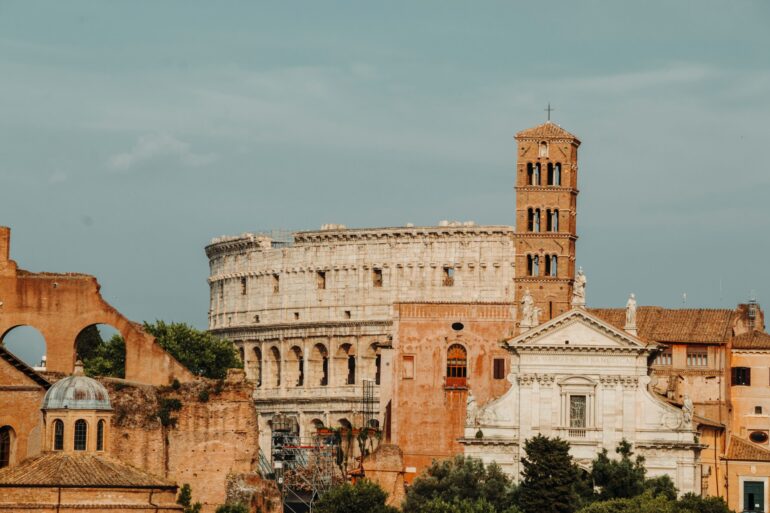
The best spot to start your first day of your fast-tour in Rome is the Colosseum, easily reachable with the Metro B. The Colosseum, built between 70 and 80 A.D., is an ancient monument that worked as an entertainment hub for Ancient Romans. As we watch soccer matches at the stadium, they assisted to incredibly gruesome spectacles, naval battles, and people being eaten alive by wild animals! Of course, there is always a lot of queues, but you can skip it by purchasing a ticket or a Colosseum tour online. The entrance to the site also includes a visit to the Roman Forum.
The Forum was effectively the downtown of the ancient city, now partly covered by Via Dei Fori Imperiali, constructed under Benito Mussolini. Yet, you will still see much of it, where the ancient markets were, Trajan’s Column, and numerous other iconic sites. Towering above the Colosseum and the Roman Forum stands the Palatine Hill, one of Rome’s seven hills. It is an open-air archeological site, and as one of the most ancient parts of the city, it hosts numerous monuments, such as the Temple of Cybeles and the Houses of Livia and Augustus. Take a half-hour break and enjoy what is around you. If you’d like, you can also book a private tour of the Colosseum, Roman Forum and Palatine hill here.
Explore Circo Massimo and the Baths of Caracalla
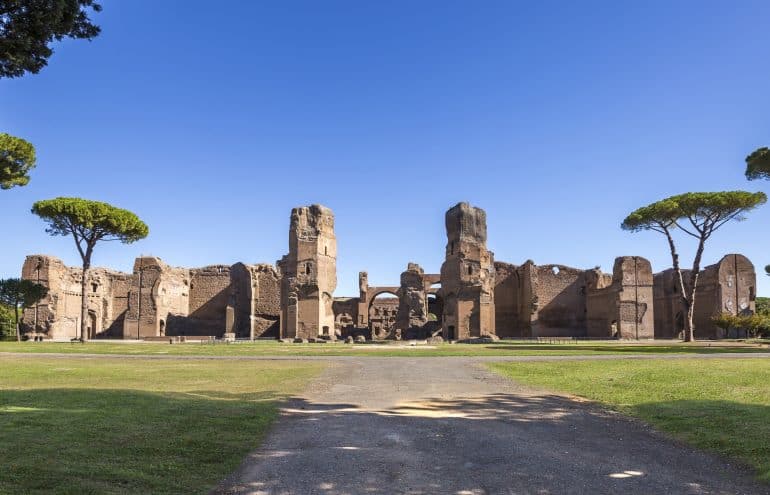
Just next to the Colosseum and the Forum is the Circo Massimo, an ancient Roman chariot-racing stadium. Today it’s a public park, but you can still imagine the shape, and if you try hard enough, you can hear the sound of the quadriga’s racing and the horses galloping. If you need some help imagining the way the stadium used to be, book your Circo Maximo Experience ticket – which allows us to see into the past and experience Roman life at the famous arena with AR.
Just by crossing the street, you can reach the Terme di Caracalla. In Rome, there is a saying that goes “le Terme di Caracalla, dove i Romani giocavano a palla”, meaning “the thermal baths of Caracalla, where Romans played ball”. In fact, the Baths were the city’s second-largest Roman public bath complex. This was a place meant for relaxation, recreation, and self-care. Its stunning and monumental dimensions would make anyone feel like an ant, and the park is perfect for a relaxing stroll. You can also visit these baths with the help of AR!
Head to the Mouth of Truth and Aventine Hill

With a ten-minute walk from the marvellous Baths, you can reach the Bocca Della Verità, the “Mouth of Truth”, one of the most famous symbols of Rome. The legend says that the marble disk would bite off the hand of anyone who lied while sticking their hand in its mouth. Although there is usually a very long line, it is worth a try. But if it bites you don’t blame it on us!
After you survive your encounter with the Mouth of Truth, you can head up the Clivio Dei Publicii and relax in the Giardino Degli Aranci – The Orange Garden – which offers a stunning view of the City and the Tiber River. With just a minute walk you can get to Piazza Dei Cavalieri di Malta. If you see a group bending over to look into a keyhole, then you’re in the right place. I am not going to spoil you the surprise, just do the same thing those other people are doing.
When you’re done with the Orange Garden you can head back to Mouth of Truth. Keep walking along Via Luigi Petroselli, with the Foro Boario on your left, and you will eventually get to something that looks like the Colosseum, Teatro Marcello. This theater was built in 13BC and still remains a stunning view.
Visit the world’s oldest public museums
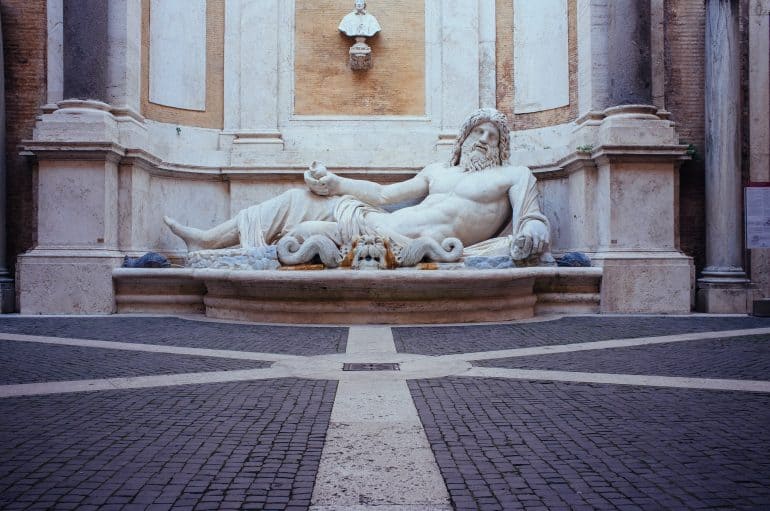
If you keep walking on Via di Teatro Marcello, on your right you will find a steep staircase which will bring you to the Capitoline Hill, the smallest of the seven hills of Rome. You will probably meet some newly-weds taking pictures. At the center of Piazza del Campidoglio, you will see a replica of the statue of Marcus Aurelius. The Capitoline Hill was, and still is, an important political hub for the city of Rome. Here you can visit the stunning Capitoline Museums, where you will be able to see the original statue of Marcus Aurelius on his horse.
In the same area stands what Romans know as the Vittoriano complex (Victor Emmanuel II National Monument) which hosts another historical museum and temporary exhibitions. Inaugurated in 1911, the monument is an immense and grandiose neoclassical monument built in honor of the first king of unified Italy. You can reach the top of the monument and get a wonderful view of the city by visiting the panoramic terrace. In Piazza Venezia, the square in front of the Victor Emmanuel II National Monument, you will be able to see the balcony of Palazzo Venezia, from which Benito Mussolini gave some of modern history’s most crucial speeches.
Go shopping, sightseeing and have lunch

Starting in Piazza Venezia, Via del Corso, one of Rome’s main shopping hubs, can become your signpost in order not to get lost. Strolling down the Corso, you will find the Alberto Sordi Galllery, Via Dei Condotti and Via Frattina’s high-end boutiques, and much more.
Turning left on Via del Caravita, which then becomes Via del Seminario, you can reach Piazza Della Rotonda, where the Pantheon is. This incredible monument was a temple dedicated to all the Gods back in ancient times, and the hole in the dome (oculus) is the only source of light in the temple. Although the ceiling is effectively open, seldom rain comes in.
When you’re done with the Pantheon, you can walk back towards Via del Corso and turn right on Via Dei Sabini – which then becomes Via Dei Cruciferi – and admire the wonderful Trevi Fountain. This is a tourist attraction in the real sense of the word: it is packed with people from all over the world, every day, each day of the year, and it truly is a sight. Pay attention to where you’re throwing your coin and good luck for taking a picture in one of the most iconic places on Earth! If during your two days in Rome you wanted to take a cooking class, there’s a great pasta-making class you can book here.
Heading back to Via del Corso and, on the left, you will see Piazza Colonna with its Column of Marcus Aurelius, and Palazzo Chigi, the official residence of the Prime Minister of Italy. Turn right on Via Dei Condotti you will reach the Spanish Steps. Here you can admire the wonderful Barcaccia Fountain and the Church of Trinità de’ Monti, which you can reach by walking up the stairs. The view is stunning at all hours of the day.
Get wow views and relax in the Villa Borghese gardens
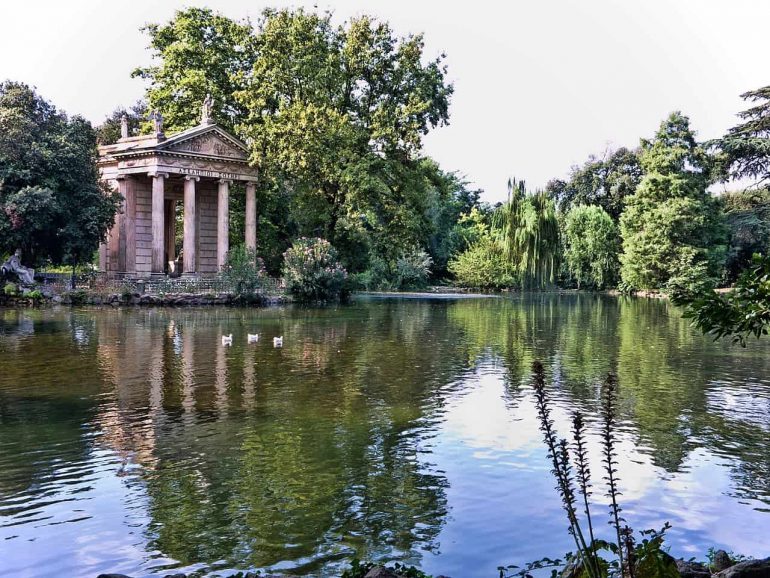
Piazza di Spagna is well connected to Piazza del Popolo, one of Rome’s main squares, through Via del Babuino, with its Babuino Fountain and the All Saint’s Anglican Church of Rome. For centuries, Piazza del Popolo, inside the Aurelian Walls, was a spot for public executions. Now you can just enjoy some time there and take a break on the Egyptian obelisk’s stairs. From the Piazza, you can see the Pincio, another of Rome’s seven hills, which hosts one of the most beautiful parks of the city, Villa Borghese.
Villa Borghese is the third biggest park in the City and is a landscape garden, perfect for reading a book or strolling under the trees, far away from the city center’s traffic. It was constructed on the Pincian Hill, therefore it offers numerous sightseeing spots to admire the mightiness of the Eternal City from above. Here you can rent a bike or a rickshaw. It contains several attractions such as a perfect reproduction of the Shakespearian Globe Theater, the beautiful neoclassical Temple of Aesculapius, and Piazza di Siena, a famous square where each year one of the most important equestrian competitions in the world takes place. If you’d like to discover Villa Borghese in a fun way, book your interactive treasure hunt (also great for kids)!
If you’re short on time, you can visit both the Vatican and the Colosseum in a single day.
DAY 2 IN ROME: Prati, Trastevere & the Jewish District
Visit the Vatican Museums
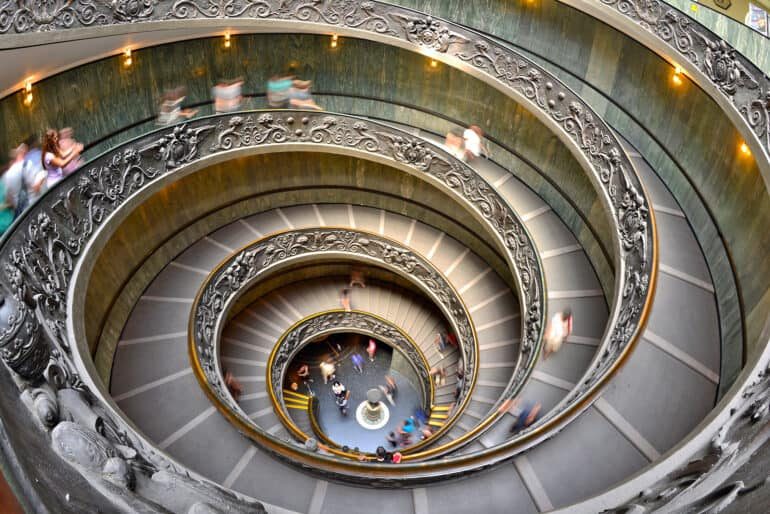
Your second day in Rome will be as busy as the first one, but you’ll manage! If you want to start from where we stopped yesterday, take the Metro A in Piazza del Popolo and reach the Ottaviano station.
You have effectively crossed the Tiber river and are now in Prati, another central area of Rome! Walk on Via Ottaviano and get to. From here two main traffic arteries of Rome start: Via Cola di Rienzo, with its elegant buildings and shops, and Via Crescenzio, which gets you directly to Piazza Cavour.
With a 5-minute walk from Piazza Risorgimento, you can also get to Piazza San Pietro, which hosts the biggest Basilica in the world, and is part of the Vatican City, which is effectively a state in its own right! Here you can visit Borgo Pio and the marvellous Vatican Museums, but try to book your ticket or Vatican tour in advance: the lines are long, and you don’t want to waste an entire morning just waiting to reach the entrance.
After you visited the Museums and the Basilica, walk towards the Tiber river on Via Della Conciliazione, reaching Lungotevere Castello – and don’t forget to turn around to admire St. Peter’s from a distance. Here is the wonderful Castel Sant’Angelo and the stunning Ponte Sant’Angelo. The building was initially commissioned by the Roman Emperor Adrian as a mausoleum for himself and his family, but it later became a fortress for the popes.
If you have some time on your hands, a visit to Monte Mario, the highest hill in Rome, is worth the visit. You can get there via public transportation or a taxi, and it offers one of the most stunning views of the city. At the top of the hill, there is also a restaurant, Lo Zodiaco, and a park.
Explore the colorful Trastevere

When you are done filling up your eyes with the beauty, you can head down towards Trastevere, a neighborhood that will offer you numerous eating options, so it is a good idea to stop here for a meal. Or better yet, why not lunch with the pizza you learned to make during a pizza-making class?
Trastevere is one of the most iconic neighborhoods in Rome. Its name derives from Latin’s trans Tiber, which literally means “beyond the Tiber”. It once was a very popular district. Now it has become one of the main centers of nightlife after its recent gentrification. It hosts some very nice bars, cafes, and restaurants. But what you really cannot miss are Piazza Trilussa, Piazza di Santa Maria in Trastevere and its beautiful Church, and Piazza di San Calisto, where you can grab a beer at the super-famous eponymous bar. Stroll around for a while and get lost in the small, colorful alleys. The neighborhood is also filled with lovely shops so if you’re into arts and crafts, get yourself booked into this wonderful mosaic-making workshop (yes, you get to make your own and take it home with you)!
Head to the second highest hill in Rome
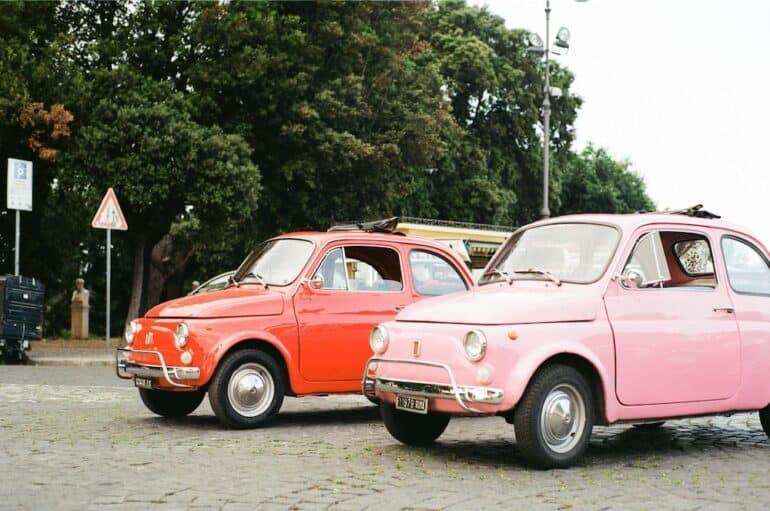
Just over Trastevere is one of the most beautiful sights in Rome, the Janiculum. The Janiculum is the second highest hill in Rome after Monte Mario, and as the latter does not figure in the proverbial seven hills of the city because it is west of the Tiber and outside the walls of the ancient city. From up here, you will be able to recognize numerous of the monuments and areas you visited during your stay. Heading back to Trastevere, you have two options.
You can either head towards the Tiber Island, from where you’ll be able to easily reach the Jewish Ghetto. This area has an especially important historical significance. Of course, this area is full of nice little boutiques and typical Roman restaurants where you can try the Jewish Style Artichokes. Yet, the Jewish Ghetto, established in 1555, still hosts the oldest Jewish community in the world, an incredible Synagogue, and a museum of Jewish history. Walking around this area you will sometimes see some golden platters on the floor with names carved in them: the stones are dedicated to the 1023 people who were deported during Nazi-Fascism. Only 16 of them survived.
Or you can cross Ponte Sisto and head directly towards Piazza Navona and its three beautiful fountains, and Campo de’ Fiori – with its array of bars, pubs, restaurants, and a monument to the subversive philosopher Giordano Bruno, perfect for ending your second day of visits around the city and relaxing with a good glass of wine.
Where to eat or sleep during your stay in Rome
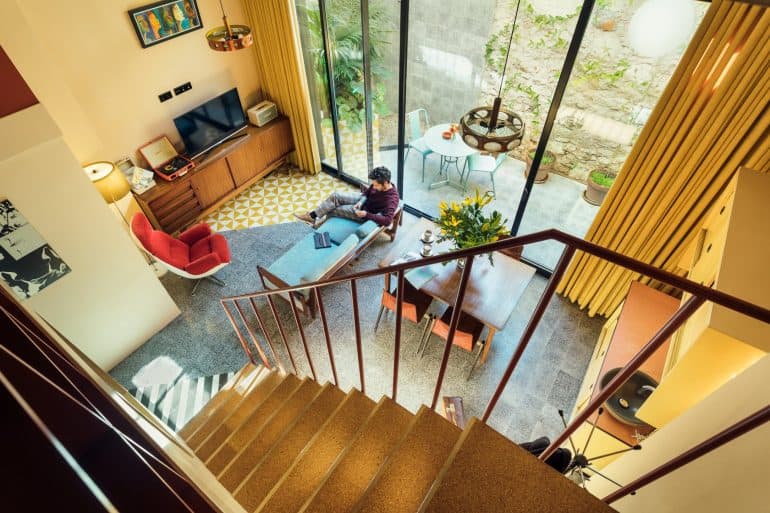
Take a look at our neighborhood guides of Prati, the Historic Center, Trastevere, and Campo de’ Fiori to find the perfect fits for you. Here’s also a list of some budget accommodations in Rome!
Cool activities for your two days in Rome
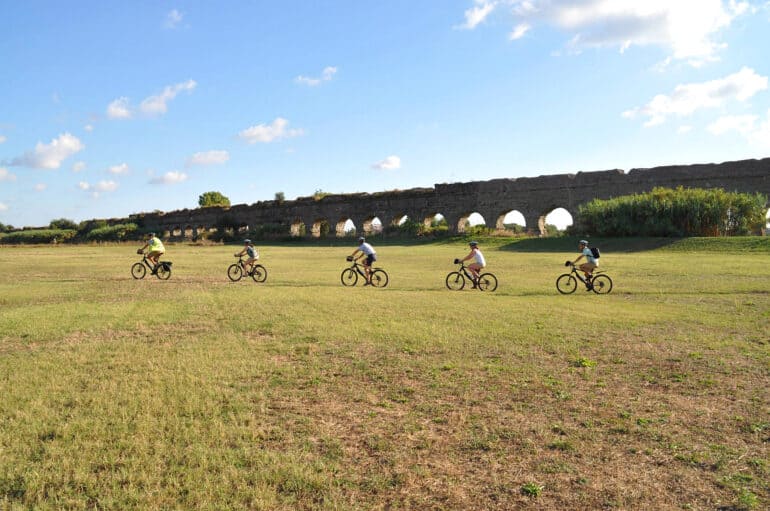
Whether you’re visiting Rome for the first time or you know the city quite well, we’ve got a few great activities to recommend. From biking along the Ancient Appian Way to wine tasting in a boutique enoteca in Campo de’ Fiori and making your own mosaics in Trastevere, there are plenty of amazing activities to do in Rome.
Travelling with kids?
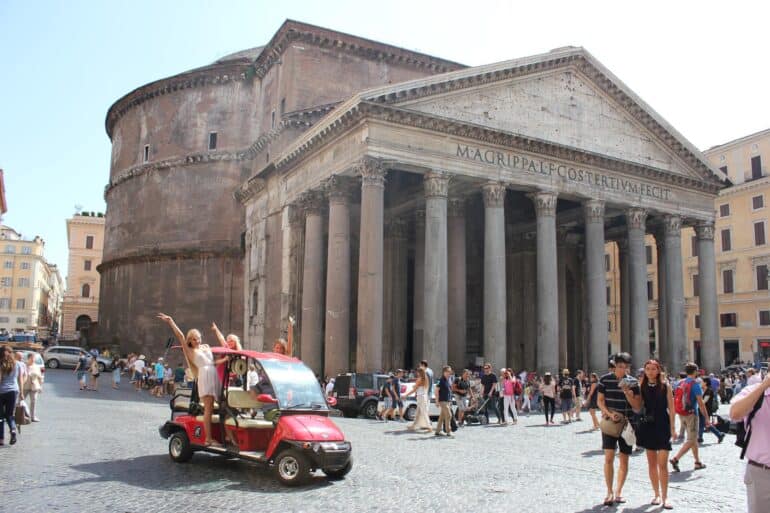
If you’re spending your time in Rome with kids, the last thing you want to do is walk too much or visit museums/monuments for a long time. We suggest you book a golf cart tour for the family! This way, you’ll get to see Rome in a fun and interactive way with a guide. You’ll be able to turn a long walking tour into an adventure!


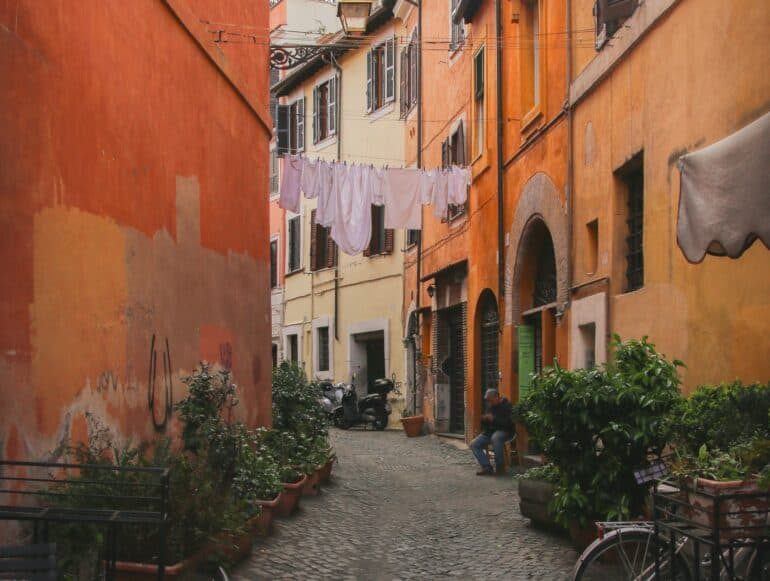




Loved your descriptions. Have loved my five visits to Rome, and looking forward to my next five visits.
Ciao